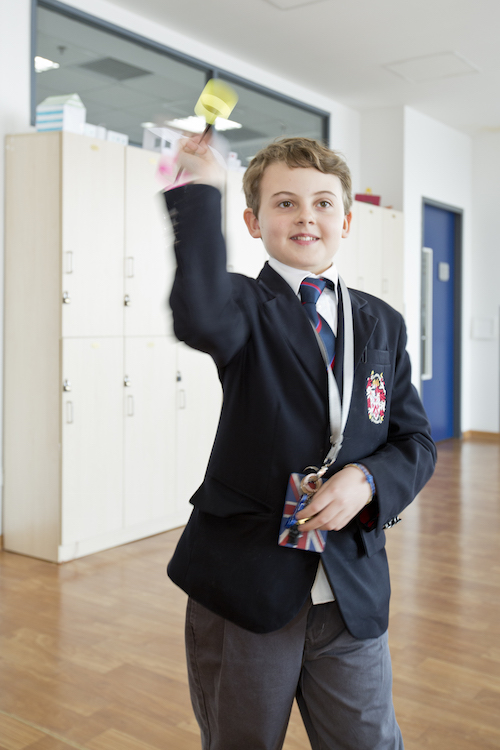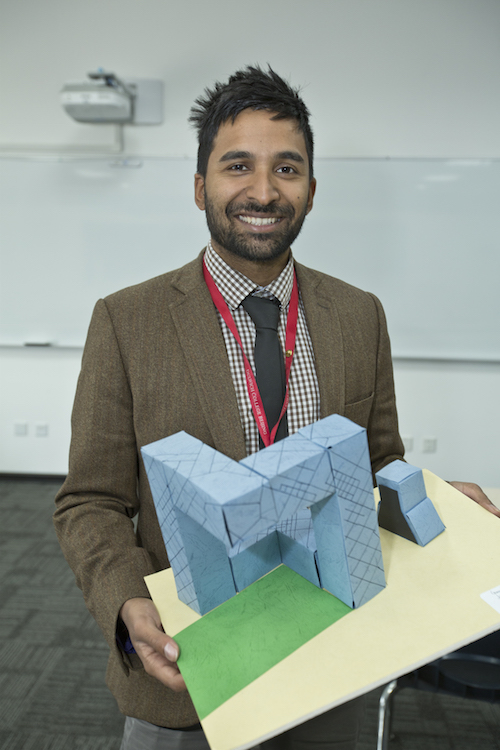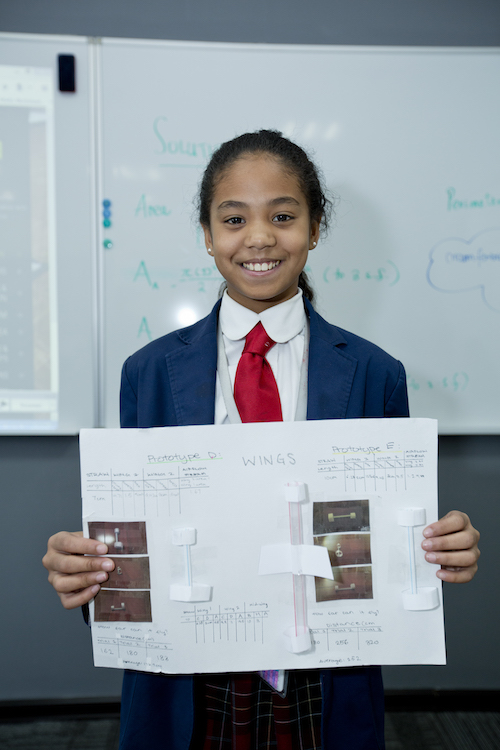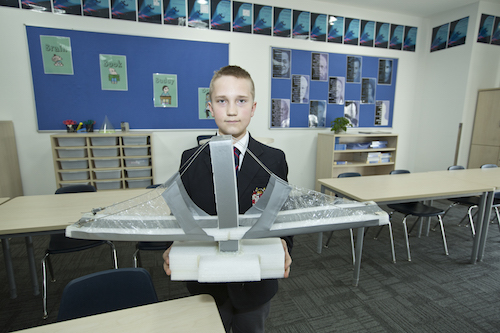
Cameron throws his paper airplane, and watches with glee as it sails past his classmates. Despite how that sounds, he isn’t acting up— instead, he is following his teacher’s instructions. The 12-year-old American student, enrolled in Year 7 at Dulwich College Beijing (DCB), designed the airplane as one of his mathematics class projects.
And that’s not the only revolutionary aspect of the course. In fact, its entire curriculum has been turned inside out in a new “flipped classroom” model that is designed to put the onus on students, rather than have them sitting and listening for too long.
“The best thing about this is that it’s independent learning. They are completely in charge of their own progress,” says Bernard D’Souza, who hails from England and teaches Year 5-13 mathematics at DCB, of the school’s flipped classroom approach. He goes on to describe how the model works: teachers don’t lecture in class, but instead make instructional videos during their prep time with clear, eye catching graphics and animations. Students are tasked with watching these videos at home, so that they arrive in class ready to work on exercises that test their comprehension, before being permitted to move on to fun, hands-on projects like designing paper airplanes, or models of bridges and buildings.
Below D’Souza and his colleagues— Chris Stanley, who is also British and works as the school’s head of mathematics, and Katrijn Ganne, a Flemish DCB mathematics teacher for Years 7-12— tell us more about why flipped classrooms may be the way of the future. We’ll also hear from the DCB students, like Cameron, who are relishing this opportunity to take more ownership of their learning.

Chris Stanley
In a flipped classroom the teacher is a facilitator, rather than a sage on the stage. We spend the class going around helping students with the work. By having the instruction happen at home, as the students watch the videos, you’ll have a lesson of 55 minutes with real learning at school, where students move around and talk about the work.
We have a problem in mathematics classes around the world: setting. Too often, we have set the students by ability. This causes issues because the bottom set will have a lot of negativity about the subject. We have now eliminated those streams in our Year 7 classes. Instead, the students can watch the instructional videos at home, at their own pace, then spend class time with their teacher and their peers getting help with the comprehension exercises.
This new system makes the students work harder, because they don’t want to see their friends get too far ahead of them. That’s more motivating than anything I can tell them. In such an environment, there’s nothing to hold you back but your efforts.
It’s not only teaching them skills, but also independent learning and organisation. There’s all these extra skills involved, so they’re taking real responsibility for their education. These are skills that will not only help them in school, but throughout life in all the things they’ll do.

Katrijn Ganne
The biggest benefit is that the students can work at their own pace. I have some students doing the final chapter right now, while others are taking the time they need to understand the midway chapters. So they can take it steady and slow when they have to. But, at same time, they’ll see the others moving along, and think: “Ok, I’ll do more work to keep up.” We don’t have to push them.
The parents are amazed at how innovative this is, because the students learn how to plan their own work. This approach is more student focused, because many students are coming to class doing exercises at different stages of the curriculum, depending on how quickly they’ve gone through the instructional videos at home. That means the teacher is constantly circulating during class time, and is never at their own desk or standing at the front and lecturing. It’s more work for the teachers— especially when you consider how much time it takes to make the instructional videos, and how much individual attention each student needs. But that means it’s more beneficial for the students.
Flipped classrooms are also very good for English as an Additional Language (EAL) students. Many of them are very shy initially, and afraid to make a mistake when they speak, especially when the teacher spends all their time at the front of the room, on high. But with this new setup, the teacher is constantly approaching them, and the students are constantly working with each other.
After they finish the videos at home, and work through the comprehension exercises in class, the students are then freed up to do more hands-on projects. One of my students made a scale map, and it was a great cross curricular opportunity with art, because she’d burned its edges to make it look like an ancient treasure map. For another project, the students had to make a miniature bridge, then determine how much weight it could sustain. They really enjoyed measuring how much their models could take, and eventually destroying them with too much weight. I think it blew their minds to have a productive reason to do something as fun as destroy their work!

Bernard D’Souza
The projects— like making airplanes, bridges and maps— are hugely motivating for the students. My students especially loved making paper airplanes with straws, figuring out the aerodynamics and surface area that would take their planes as far as possible. They’re striving to finish the instructional videos at home, and comprehension work in class, so that they can get to those fun, hands-on projects.
This makes them more independent. They’ll need to know the work very well, to progress at their own pace, and that compels them to come to the teacher when they need help. So the environment is much friendlier, and makes the students more confident to speak to the teacher and each other.
That’s what university is like: you’re in charge of doing the work yourself. You need to ensure you understand the lessons, and do the revision that’s required. They’re tasked with watching the videos at home and coming prepared to class to work. And if they choose to lag behind and watch the videos in class, then they’re missing that face time that they could be using to ask the teacher about questions that they’re stuck on. Every child pushes back when an adult tells them to do something, so having them decide what they’re going to do, and when, is a far bigger incentive.

Cameron, Year 7, aged 12
I like planes. I also like making stuff out of materials that you can find in your house. I made two planes, and the biggest one flew for four metres, which was pretty successful. I dream of becoming a pilot someday, so this project was perfect for me.

Christina, Year 7, aged 11
I like doing the paper airplane project because I like making stuff. It was really fun, and I got to see which plane flew the farthest, and I got to learn why it went the farthest. It was fun to take what we learned in mathematics and do something different with it.

Natasha, Year 7, aged 11
I’ll remember what we learned in this lesson, because it was hands-on. It felt practical and useful.

Ayo, Year 7, aged 11
My plane flew for two metres. I’m pretty proud of it, yes, you could say that (laughs). It was a fun way to learn. And I’m glad that we didn’t get in trouble for throwing things.

Tobias, Year 7, aged 12
It was challenging to make a model bridge. I was using a glue gun, but it was too hot and was melting the plastic. So I taught myself how to regulate that by turning the gun off and on, and waiting for it to cool.
I just enjoyed making the bridge, because I always like constructing things. I also learned a lot about tension and design by putting weights on the bridge in class with the teacher, and seeing how much the bridge could sustain. Maybe someday I’ll become an engineer.
 This is the third in a series of posts brought to you by Dulwich College Beijing. DCB is made up of over 1430 students from age one to 18, with over forty-five nationalities represented in its diverse student body. It is a British international school, offering an educational environment designed to nurture not only the intellectual and physical but also social and emotional development of students. The school takes pride in an excellent pastoral care programme, as well as superb IB results. The school’s "flipped classroom approach" is just one of its many strengths.
This is the third in a series of posts brought to you by Dulwich College Beijing. DCB is made up of over 1430 students from age one to 18, with over forty-five nationalities represented in its diverse student body. It is a British international school, offering an educational environment designed to nurture not only the intellectual and physical but also social and emotional development of students. The school takes pride in an excellent pastoral care programme, as well as superb IB results. The school’s "flipped classroom approach" is just one of its many strengths.
Photos: Uni You



